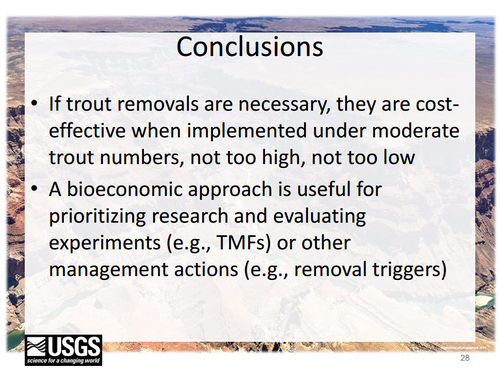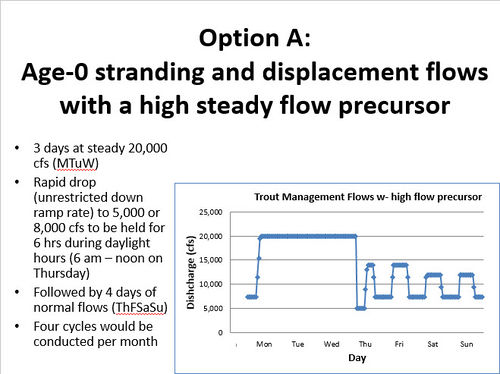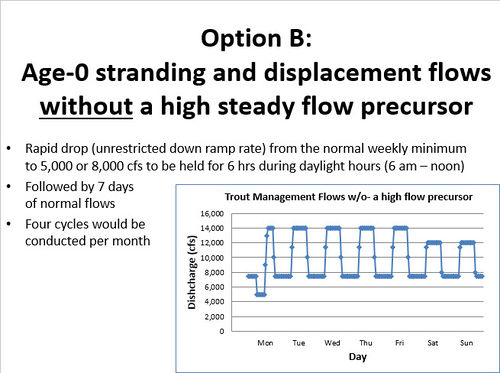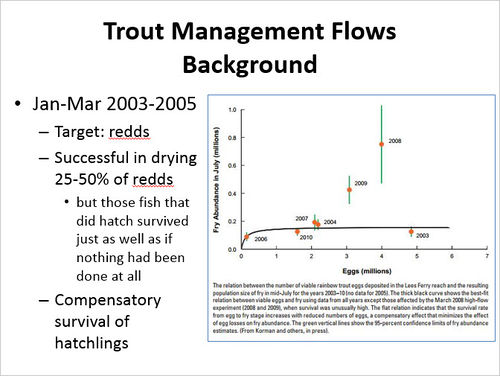|
|
| Line 56: |
Line 56: |
| | | | |
| | [[File:TMFsBackground.jpg|center|500px]] | | [[File:TMFsBackground.jpg|center|500px]] |
| − |
| |
| − | |}
| |
| − |
| |
| − |
| |
| − | <!--
| |
| − |
| |
| − | --------------------------------ADDITIONAL------------------------------->
| |
| − | |class="MainPageBG" style="width:45%; border:1px solid #cedff2; background:#f5faff; vertical-align:top;"|
| |
| − | {| width="100%" cellpadding="2" cellspacing="5" style="vertical-align:top; background:#f5faff;"
| |
| − | ! <h2 style="margin:0; background:#cedff2; font-size:120%; font-weight:bold; border:1px solid #a3b0bf; text-align:left; color:#000; padding:0.2em 0.4em;">Links</h2>
| |
| − | |-
| |
| − | |style="color:#000;"|
| |
| − |
| |
| − | *[http://gcdamp.com/index.php?title=FISHERY The Lees Ferry Rainbow Trout Fishery Page]
| |
| − | *[http://gcdamp.com/index.php?title=Brown_Trout Brown Trout Page]
| |
| | | | |
| | |- | | |- |
| Line 116: |
Line 101: |
| | increased based on experimental testing to as many as three cycles per month for 3 months (May, | | increased based on experimental testing to as many as three cycles per month for 3 months (May, |
| | June, and July). | | June, and July). |
| | + | |
| | + | ==[http://ltempeis.anl.gov/documents/final-eis/vol1/Chapter_2-Alternatives.pdf LTEMP FEIS Chapter 2, pages 63-66]== |
| | + | |
| | + | TMFs (described in Section 2.2.3.2) are a potential tool that could be used to control |
| | + | annual trout production in the Glen Canyon reach for purposes of managing the trout fishery and |
| | + | for limiting emigration from the Glen Canyon reach to Marble Canyon and the Little Colorado |
| | + | River reach. If resource conditions are appropriate, TMFs may be tested under Alternative D |
| | + | early in the experimental period, preferably in the first 5 years. These first tests could be |
| | + | triggered by modeled trout recruitment levels or otherwise implemented to test the effectiveness |
| | + | of TMFs. The intent of these early tests would be to determine the effectiveness of TMFs and a |
| | + | best approach to trout management. If TMFs are determined to be effective for controlling trout |
| | + | numbers while minimizing impacts on other resources, they may be deployed as an adaptive |
| | + | experimental treatment triggered by estimated trout recruitment. |
| | + | |
| | + | It should be noted that several Tribes have expressed concerns about TMFs as a taking of |
| | + | life within the canyon without a beneficial use. The Pueblo of Zuni has expressed concern that |
| | + | the taking of life by trout stranding has an adverse effect on the Zuni value system. The jointlead |
| | + | agencies will continue to work with the Tribes regarding options for trout management, and |
| | + | to determine the most appropriate means of mitigating impacts on Tribal values if TMFs are |
| | + | implemented. |
| | + | |
| | + | As many as three TMF cycles/month (see Section 2.2.3.2) in a period of up to 4 months |
| | + | during May through August could be tested, depending on the results of early tests. Aspects of |
| | + | TMF design that would be investigated include: |
| | + | *Duration of high flows needed to lure YOY rainbow trout into near-shore habitats, |
| | + | *Magnitude of the high flow that would be more effective in luring YOY trout to near-shore habitats, |
| | + | *Whether or not moving to high flows first is needed to reduce YOY trout numbers (as opposed to simply dropping rapidly from normal flows to minimum flows), |
| | + | *Timing of TMF cycles during the May–August period of trout emergence, and |
| | + | *Number of cycles necessary to effectively limit trout recruitment. |
| | + | |
| | + | If TMFs prove to be effective in controlling trout production and emigration to the Little |
| | + | Colorado River reach, and they become an integral part of the LTEMP, regular implementation |
| | + | of TMFs may need to include variable timing to prevent adaptation of the population to specific |
| | + | timing (e.g., increase in recruitment by fall-spawning rainbow trout). |
| | + | |
| | + | Certain aspects of TMF effectiveness can be addressed through observational studies |
| | + | (e.g., the number of YOY rainbow trout observed in the near-shore environment in daily |
| | + | increments after the high flow is initiated); others may be addressed through consideration of |
| | + | the physical environment in Glen Canyon (i.e., what areas are inundated or exposed at different |
| | + | flows). Ultimately, however, effectiveness would be judged based on comparison of fall trout |
| | + | recruitment estimates to expectations based on prior years. It may take several years to make this |
| | + | determination, depending on the strength of the response and the type of TMFs tested. |
| | + | Ultimately, however, effectiveness would be based on the ability of TMFs to reduce recruitment |
| | + | in and emigration from the Glen Canyon reach. The driving forces behind emigration are not |
| | + | fully understood, but are expected to be related to population size and food base in the Glen |
| | + | Canyon reach. |
| | + | |
| | + | For the EIS modeling, a trigger of 200,000 YOY trout was used to determine when TMFs |
| | + | would be implemented. A regression equation based on annual volume, the variability in flows |
| | + | from May through August, and the occurrence of a spring HFE was used to predict the number |
| | + | of YOY. The actual trigger used could be higher or lower depending on the results of |
| | + | experiments that will be conducted on the effectiveness of TMFs. In addition, the predictive |
| | + | regression equation could be modified based on new information. The trigger and predictive |
| | + | equation used would be modified as needed in an adaptive management context utilizing the |
| | + | process described in Section 2.2.4.3. Triggers for implementation of TMFs would also be |
| | + | developed in consultation with the AZGFD and other entities as appropriate. |
| | + | |
| | + | Monitoring of other resources, particularly food base and the physiologic condition of |
| | + | adult rainbow trout, would also be considered. In addition, the number of YOY trout at the end |
| | + | of the summer would be estimated to determine if it equals or exceeds the estimated number of |
| | + | recruits needed to sustain the desired number of adult trout. If the estimated number of recruits is |
| | + | less than the recruitment target, TMFs would be re-evaluated for modification before |
| | + | implementation in subsequent years. It is anticipated that the trout population could rebound |
| | + | from a 1-year drop below this target level. |
| | + | |
| | + | As discussed in relation to sediment experiments above, there is concern among scientists |
| | + | and stakeholders with regard to the risk associated with implementation of spring HFEs as |
| | + | related to trout response and subsequent effects on the humpback chub population. For this |
| | + | reason, TMFs would be implemented and tested for effectiveness as early in the LTEMP period |
| | + | as possible, preferably before the first spring HFEs are triggered, even if not triggered by high |
| | + | trout recruitment. TMFs could be implemented in years that feature a spring HFE and in the |
| | + | water year that follows an equalization flow because of the expected positive effects of |
| | + | equalization on rainbow trout recruitment. Any implementation of TMFs would consider the |
| | + | status of the trout fishery prior to implementation. Modeling indicates TMFs would be triggered |
| | + | by trout recruitment numbers in 32% of the years in the LTEMP period. |
| | + | |
| | + | There is potential for confounding effects when coupling TMFs with HFEs. If trout |
| | + | recruitment is still high after implementation of TMFs that follow HFEs, this would suggest |
| | + | TMFs were not effective as designed for that trial. If recruitment is lower than expected after |
| | + | TMF implementation, however, uncertainty will remain about whether an HFE failed to |
| | + | stimulate trout recruitment or whether TMFs were effective in suppressing otherwise strong |
| | + | recruitment. It may not be necessary to determine the underlying effect on trout numbers unless |
| | + | TMFs have undesirable side effects on other resources or the trout population. |
| | + | |
| | + | If TMFs are found to be highly effective in controlling trout recruitment and emigration |
| | + | of trout, and emigration only occurs or primarily occurs immediately following high recruitment |
| | + | years, it may be possible to limit TMF implementation and achieve multiple resource goals, |
| | + | particularly if unintended impacts of TMFs on other resources such as native fish become |
| | + | evident. Timing of TMFs may also be adjusted based on the best scientific information available |
| | + | related to trout emigration behavior. If adverse impacts of TMFs become evident, this may also |
| | + | suggest revisiting whether or not TMFs are necessary in response to spring HFEs. Lastly, if, |
| | + | there is an observed increase in trout recruitment due to fall HFEs, then application of TMFs in |
| | + | the spring following a fall HFE would be considered. |
| | + | |
| | + | Implementation of TMFs would consider resource condition assessments and resource |
| | + | concerns using the processes described in Sections 2.2.4.3 and 2.2.4.4. TMFs may not be tested |
| | + | when there appears to be the potential for unacceptable impacts on the resources listed in |
| | + | Section 2.2.4.3. |
| | | | |
| | ==[https://www.fws.gov/southwest/es/arizona/Documents/Biol_Opin/120059_LTEMP%20BiOp_11-25-16.pdf LTEMP Biological Assessment, pages 30-41 ]== | | ==[https://www.fws.gov/southwest/es/arizona/Documents/Biol_Opin/120059_LTEMP%20BiOp_11-25-16.pdf LTEMP Biological Assessment, pages 30-41 ]== |
| Line 123: |
Line 206: |
| | Little Colorado River reach. TMFs would be tested early in the experimental | | Little Colorado River reach. TMFs would be tested early in the experimental |
| | period, preferably in the first 5 years. Under the LTEMP EIS, TMFs could occur from May to August. | | period, preferably in the first 5 years. Under the LTEMP EIS, TMFs could occur from May to August. |
| | + | |
| | + | |} |
| | + | |
| | + | |
| | + | <!-- |
| | + | |
| | + | --------------------------------ADDITIONAL-------------------------------> |
| | + | |class="MainPageBG" style="width:45%; border:1px solid #cedff2; background:#f5faff; vertical-align:top;"| |
| | + | {| width="100%" cellpadding="2" cellspacing="5" style="vertical-align:top; background:#f5faff;" |
| | + | ! <h2 style="margin:0; background:#cedff2; font-size:120%; font-weight:bold; border:1px solid #a3b0bf; text-align:left; color:#000; padding:0.2em 0.4em;">Links</h2> |
| | + | |- |
| | + | |style="color:#000;"| |
| | + | |
| | + | *[http://gcdamp.com/index.php?title=FISHERY The Lees Ferry Rainbow Trout Fishery Page] |
| | + | *[http://gcdamp.com/index.php?title=Brown_Trout Brown Trout Page] |
| | | | |
| | |- | | |- |
Updates
|
|
[2]
|
Descriptions of Trout Management Flows
|
|
TMFs are a special type of fluctuating flow designed to reduce the recruitment of trout by
disadvantaging YOY trout (Figure 2-15). TMFs have been proposed and developed on the basis
of research described in Korman et al. (2005). The underlying premise of TMFs is based on
observations that YOY trout tend to occupy near-shore shallow-water habitats to avoid predation
by larger fish. TMFs feature repeated fluctuation cycles that consist of relatively high flows
(e.g., 20,000 cfs) sustained for a period of time (potentially ranging from 2 days to 1 week)
followed by a rapid drop to a very low flow (e.g., 5,000 cfs to 8,000 cfs). This low flow would
be maintained for a period of less than a day (e.g., 12 hr) to prevent adverse effects on the food
base. Low flows would be timed to start in the morning, after sunrise, to expose stranded fish to
direct sunlight and heat. Up-ramp rates to the TMF would be the same as the limit for this
alternative overall (i.e., 4,000 cfs/hr). The down-ramp from peak to base would be over a single
hour (e.g., 15,000 cfs/hr for a drop from 20,000 cfs to 5,000 cfs). In a TMF flow cycle, YOY
trout are expected to occupy near-shore habitat when flows are highest, and would be stranded
by the sudden drop to low flow. Because older age classes of trout tend to occupy deeper habitats
toward the middle of the river channel, they are less susceptible to stranding and are less likely to
be directly affected by TMFs. TMFs would be used to control trout recruitment in the Glen
Canyon reach to manage the rainbow trout fishery, and to limit emigration of juvenile trout to
downstream reaches, particularly to habitat occupied by humpback chub near the confluence
with the Little Colorado River. Triggers for implementation of TMFs would be determined in
consultation with the AZGFD.
It should be noted that several Tribes have expressed concerns about TMFs as a taking of
life within the canyon without a beneficial use. The Pueblo of Zuni has expressed concern that
the taking of life by trout stranding has an adverse effect on the Zuni value system. The jointlead
agencies will continue to work with the Tribes regarding options for trout management.
TMFs may be tested under this alternative early in the LTEMP period, even if not
triggered by high trout recruitment. The intent of these early tests would be to determine the
effectiveness of TMFs in reducing trout recruitment and the emigration of young trout to Marble
Canyon and the Little Colorado River reach. The condition of the trout fishery, as determined in
consultation with AZGFD, and potential impacts on other important resources would be
considered prior to implementing TMFs. If TMFs are determined to be effective for these goals
while minimizing impacts on other resources, they may be deployed on a regular or triggered
basis. TMFs would be tested two to three times in the early part of the LTEMP period while
attempting to minimize confounding effects with other experimental treatments. Tests would
start with a conservative application of two cycles in June and July (Figure 2-15), but could be
increased based on experimental testing to as many as three cycles per month for 3 months (May,
June, and July).
TMFs (described in Section 2.2.3.2) are a potential tool that could be used to control
annual trout production in the Glen Canyon reach for purposes of managing the trout fishery and
for limiting emigration from the Glen Canyon reach to Marble Canyon and the Little Colorado
River reach. If resource conditions are appropriate, TMFs may be tested under Alternative D
early in the experimental period, preferably in the first 5 years. These first tests could be
triggered by modeled trout recruitment levels or otherwise implemented to test the effectiveness
of TMFs. The intent of these early tests would be to determine the effectiveness of TMFs and a
best approach to trout management. If TMFs are determined to be effective for controlling trout
numbers while minimizing impacts on other resources, they may be deployed as an adaptive
experimental treatment triggered by estimated trout recruitment.
It should be noted that several Tribes have expressed concerns about TMFs as a taking of
life within the canyon without a beneficial use. The Pueblo of Zuni has expressed concern that
the taking of life by trout stranding has an adverse effect on the Zuni value system. The jointlead
agencies will continue to work with the Tribes regarding options for trout management, and
to determine the most appropriate means of mitigating impacts on Tribal values if TMFs are
implemented.
As many as three TMF cycles/month (see Section 2.2.3.2) in a period of up to 4 months
during May through August could be tested, depending on the results of early tests. Aspects of
TMF design that would be investigated include:
- Duration of high flows needed to lure YOY rainbow trout into near-shore habitats,
- Magnitude of the high flow that would be more effective in luring YOY trout to near-shore habitats,
- Whether or not moving to high flows first is needed to reduce YOY trout numbers (as opposed to simply dropping rapidly from normal flows to minimum flows),
- Timing of TMF cycles during the May–August period of trout emergence, and
- Number of cycles necessary to effectively limit trout recruitment.
If TMFs prove to be effective in controlling trout production and emigration to the Little
Colorado River reach, and they become an integral part of the LTEMP, regular implementation
of TMFs may need to include variable timing to prevent adaptation of the population to specific
timing (e.g., increase in recruitment by fall-spawning rainbow trout).
Certain aspects of TMF effectiveness can be addressed through observational studies
(e.g., the number of YOY rainbow trout observed in the near-shore environment in daily
increments after the high flow is initiated); others may be addressed through consideration of
the physical environment in Glen Canyon (i.e., what areas are inundated or exposed at different
flows). Ultimately, however, effectiveness would be judged based on comparison of fall trout
recruitment estimates to expectations based on prior years. It may take several years to make this
determination, depending on the strength of the response and the type of TMFs tested.
Ultimately, however, effectiveness would be based on the ability of TMFs to reduce recruitment
in and emigration from the Glen Canyon reach. The driving forces behind emigration are not
fully understood, but are expected to be related to population size and food base in the Glen
Canyon reach.
For the EIS modeling, a trigger of 200,000 YOY trout was used to determine when TMFs
would be implemented. A regression equation based on annual volume, the variability in flows
from May through August, and the occurrence of a spring HFE was used to predict the number
of YOY. The actual trigger used could be higher or lower depending on the results of
experiments that will be conducted on the effectiveness of TMFs. In addition, the predictive
regression equation could be modified based on new information. The trigger and predictive
equation used would be modified as needed in an adaptive management context utilizing the
process described in Section 2.2.4.3. Triggers for implementation of TMFs would also be
developed in consultation with the AZGFD and other entities as appropriate.
Monitoring of other resources, particularly food base and the physiologic condition of
adult rainbow trout, would also be considered. In addition, the number of YOY trout at the end
of the summer would be estimated to determine if it equals or exceeds the estimated number of
recruits needed to sustain the desired number of adult trout. If the estimated number of recruits is
less than the recruitment target, TMFs would be re-evaluated for modification before
implementation in subsequent years. It is anticipated that the trout population could rebound
from a 1-year drop below this target level.
As discussed in relation to sediment experiments above, there is concern among scientists
and stakeholders with regard to the risk associated with implementation of spring HFEs as
related to trout response and subsequent effects on the humpback chub population. For this
reason, TMFs would be implemented and tested for effectiveness as early in the LTEMP period
as possible, preferably before the first spring HFEs are triggered, even if not triggered by high
trout recruitment. TMFs could be implemented in years that feature a spring HFE and in the
water year that follows an equalization flow because of the expected positive effects of
equalization on rainbow trout recruitment. Any implementation of TMFs would consider the
status of the trout fishery prior to implementation. Modeling indicates TMFs would be triggered
by trout recruitment numbers in 32% of the years in the LTEMP period.
There is potential for confounding effects when coupling TMFs with HFEs. If trout
recruitment is still high after implementation of TMFs that follow HFEs, this would suggest
TMFs were not effective as designed for that trial. If recruitment is lower than expected after
TMF implementation, however, uncertainty will remain about whether an HFE failed to
stimulate trout recruitment or whether TMFs were effective in suppressing otherwise strong
recruitment. It may not be necessary to determine the underlying effect on trout numbers unless
TMFs have undesirable side effects on other resources or the trout population.
If TMFs are found to be highly effective in controlling trout recruitment and emigration
of trout, and emigration only occurs or primarily occurs immediately following high recruitment
years, it may be possible to limit TMF implementation and achieve multiple resource goals,
particularly if unintended impacts of TMFs on other resources such as native fish become
evident. Timing of TMFs may also be adjusted based on the best scientific information available
related to trout emigration behavior. If adverse impacts of TMFs become evident, this may also
suggest revisiting whether or not TMFs are necessary in response to spring HFEs. Lastly, if,
there is an observed increase in trout recruitment due to fall HFEs, then application of TMFs in
the spring following a fall HFE would be considered.
Implementation of TMFs would consider resource condition assessments and resource
concerns using the processes described in Sections 2.2.4.3 and 2.2.4.4. TMFs may not be tested
when there appears to be the potential for unacceptable impacts on the resources listed in
Section 2.2.4.3.
Experimental Trout Management Flows (TMFs) could be used to control annual
rainbow trout production in the Glen Canyon reach for the purposes of managing
the rainbow trout fishery and for limiting emigration to Marble Canyon and the
Little Colorado River reach. TMFs would be tested early in the experimental
period, preferably in the first 5 years. Under the LTEMP EIS, TMFs could occur from May to August.
|
|
Links
|
|
|
Information
|
|
Lees Ferry Anglers Trout Fishery Recommendations
Recommendation #5.
Under certain conditions, rainbow trout at Lees Ferry have reproduced prolifically. Historically, when there is an over-abundance of young-of-year rainbow trout, the quality and condition of rainbow trout decline. This is likely due to the low quality and low abundance of food sources in Lees Ferry. Trout Management Flows (TMFs) are flow treatments that are hypothesized to reduce the abundance of young-of-year trout by stranding trout shortly after they emerge from their redds (Korman, Ecometric Research, Inc., personal communications, 2015).
We believe the best long term and ecologically appropriate solution to controlling trout densities is to increase invertebrate diversity and manage Grand Canyon Dam flows to avoid excessive trout spawning and recruitment (see recommendations related to the aquatic food base and equalization flows). We are concerned about the collateral damage that TMFs could have on other resources especially the aquatic food base and native fish. TMFs may be especially useful when spring HFE's are implemented or in years when high equalization flows are required.
TMF's should only be implemented in a carefully designed experimental framework that includes quantified criteria for success (for managing trout recruitment and improving the humpback chub population) and the impacts to other resources, especially the aquatic food base, are fully assessed. TMF's should only be used when the rainbow trout population is stable and includes a healthy abundance of all size classes of rainbow trout. Mitigation measures such as emergency stocking of trout need to be in place prior to the implementation of TMFs in case of catastrophic loss to the fishery (see recommendations on Trout Stocking). In conclusion, the experimental evaluation of TMFs needs to recognize the trout fishery as a highly valued asset. The AZGFD should have a seat at the table along with Federal agencies on any discussion and decisions related to implementation of TMFs.
|
Presentations and Papers
|
|
2017
2012
2011
2010
2009
|
Other Stuff
|
|
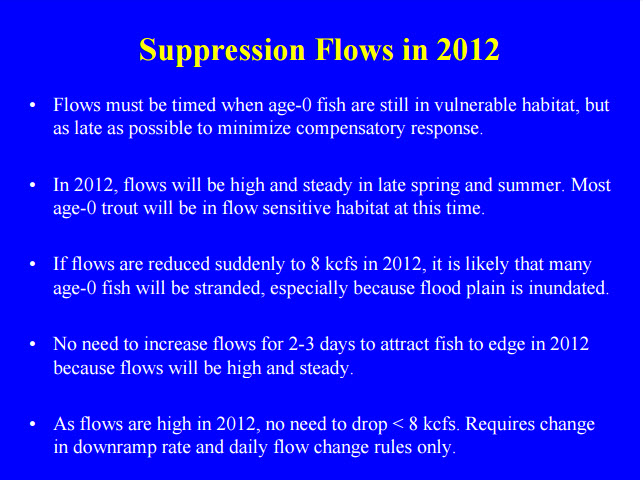
Trout Management Flows may be more effective if targeted towards juvenile trout and not eggs or hatchlings.
Juvenile trout are susceptible to fluctuating flows (adults are less so).
Reducing the number or density of juvenile trout at Lees Ferry may:
- reduce downstream migration (emigration) and conflicts with humpback chub
- reduce competition with adult trout and maintain/improve the Lees Ferry trout fishery (size, condition)
|
|

